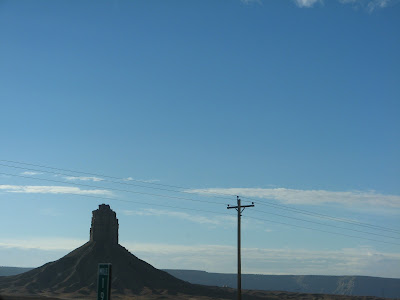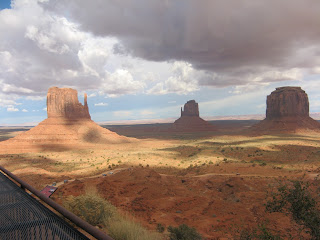It was still raining so we were keeping our fingers crossed for the clouds to lift so that it would be dry for our tour of Monument Valley.
Teec Nos Pos Trading Post is an old fashioned trading post of the Navajo Nation in the Four Corners Region. You are welcomed with the phrase Ya At Teeh (with accents on the as and the es) . This is pronounced"ya-ta-HEY and means "it is good" (to meet you). Teec Nos Pos has a Navajo meaning of circle of cottonwood trees. It is a general store but it has a back room with rugs, pottery, carved figures and basket ware, all artistic wares by the Navajo people.
Big cloth bags of flour - as Jim says like in the old days!
I loved the weaving and, particularly, the basket making, but they were horrendously expensive and, more importantly, Jim was at my elbow hissing under his breath!
So it was Farewell to Teec Nos Pos Trading Post and back to our scenic route.
Could buy that Mesa but rather hard to transport home!
And finally to Mexican Hat! This is a little village on the San Juan river in the south central San Juan County of Utah. It is named after this sombrero-shaped rock outcropping on the north-east of the town. I took this photo (and the ones en route). We stopped for Jim to take a proper photo but mine is much better!
There seems to be a lot to see in the area around Mexican Hat but sadly we did not have time. We could not go to Goosenecks State Park where the San Juan twists and turns to give the longest entrenched river meander in North America. We could not go to Valley of the Gods, a miniature Monument Valley with sandstone formations called Seven Sailors, Southern Lady, Battleship Butte. Jim comforted me saying that we wouldn't have gone anyway because it is an unpaved road and we were driving a rental car!
We stopped at the Bridge Cafe in Mexican Hat for a coffee - strange place!
And continued on our way with the massive sandstone formations of Monument Valley already to be seen in the distance. We had a long wait along this road at road work but it gave us plenty of time to admire.
And finally Monument Valley!
This is the inside of a demonstration Hogan. The Hogan is a sacred home for the Dine (Navajo) people. Every family, even if they live in a newer home, must have a hogan for ceremonies and to keep themselves in balance. They were made of wooden poles, tree bark and mud. The door of each hogan is to the east, facing the sun and to get good blessings.
It was near the hogans that we found our Navajo Spirit driver and pick up/carriage.
This is the sweat house (hogan) where members of the Navajo people go periodically for purification - it sounds absolutely horrendous, worse than the hottest sauna!
Large outcrops like these are called buttes. This is West Mitten (like a mitten, isn't it!)
This is East Mitten (like a mitten for the other hand!). There is about a mile between these 2 buttes and right in the middle is the state boundary between Arizona and Utah.
Below is Merrick Butte:
This is sentinel Mesa - the large ones with the flat tops are mesas.
Our guide was called Will Cowboy, a native Navajo. He was extremely knowledgeable and very humorous. He gave us an excellent, informative tour. His great grandfather was born on the top of a mesa a bit away from Sentinel Mesa. His family had sought the refuge of this mesa for some reason that I cannot remember. He lived till the age of 109. At the age of 102, his family would allow him no longer to ride his mustang so at the age of 5 Will became his great grandfather's minder and rode the horse with his great grandfather behind
This photo was taken using a puddle from the previous day's rain as a reflector. Nice I thought! According to Will, there had been much more rain this summer than normal and the dirt roads developed crevices, or canyons as he put it. It was so bad that many a car rental never left Monument Valley as incautious tourists, looking up or far away, drove right into the chasms!
This is Elephant Butte. If you look carefully it looks like an elephant with a howdah on its back.
The 3 pinnacles are called The Three Sisters.
A closer view of the three sisters which shows how the name was created from the shapes.
This is the view, I think, from John Ford Point, so called because of the many films he made in Monument Valley
The Big Chief Geronimo. I think it's clearer in the next photo.
Tourism is huge business in Monument Valley but the Navajo Spirit tours seem to take fewer people and seem more persona. We learned a lot from Jim Cowboy. He told us that all his ancestors were cowboys - we weren't sure if he was joking or serious. Anyway most of them were film stars as they were the extras in the films made in Monument Valley.
Monument Valley is probably most known for its use in many John Ford films including Stagecoach and The Searchers. It has also featured in Easy Rider, Forest Gump and Clint Eastwood's The Eiger Sanction and in 2 episodes of Doctor Who. It also features in many video games and in lots of commercials
Will brought us to a large cave natural arch called The Big Hogan. It is a natural amphitheatre. If you look at the black line running at the right you could imagine it as the hair/head of a Comanche Indian. When you go further into the cave the black line becomes the mane of a horse.
Then, if you lean back on the wall of the cave it becomes, seemingly (but I couldn't see it), a huge eagle with a baby eagle under its wing. Will could tell me anything and I would believe it!
Then Will, taking advantage of the cave's great acoustics, treated us to a few songs. One was a love song used by male Navajos to woo a woman. He's a good singer and drummer. His hand drum is a bit like a bodhran. He also told us about the hand print which is so important to the Navajo - it means 4 clans to one person.
Moccasin Arch.
The Ear of the Wind Arch.
The Big Hogan from a distance as we were returning.
This is called The Totem Pole. We were 2 1/2 miles away from it so it is easy to understand that we were amazed that a car had been put on top of it for a commercial. In fact, according to Will, 2 cars would fit on top of it! It has also featured in some films with various characters climbing it.
When we got back from our very bumpy tour we were, in the words of Elvis, all shook up! Not only that, the wind had got up a bit and, with other vehicles helping to churn the dust up, we has red sand in every available orifice! In order to acclimatise ourselves to that, we decided to ditch the rental for a different form of transport!
Final View!
Because I had not been able to find accommodation farther on from Monument Valley towards the Grand Canyon, we had to back track for about 45 minutes to Bluff where we stayed in the Kokopelli Inn. En route we passed Mexican Hat where I got a photo of the San Juan river:
Bluff was settled in 1880 by a group of Mormons whose major objective was Montezuma Creek, a bleak valley 15 miles away. After a long, grueling journey of 6 months over deserts and deep canyons, the buff-coloured cliffs surrounding this little green valley were too much of a temptation and the present town of Bluff was born. It is indeed a pretty little town. A very short drive had us at the Cottonwood Steakhouse where we had to share a table with a French couple. While a bit uncomfortable to start we loosened up and had a pleasant meal and evening.


















































































No comments:
Post a Comment